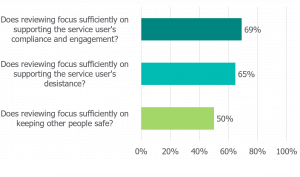Reviewing
Key findings
- Reviewing of progress should be well-informed, analytical and personalised, with changes in risks, needs and strengths and/or new obstacles to compliance and engagement identified and discussed.
- Reviewing assessments can improve prediction of reoffending by keeping dynamic risk factors up to date, providing an evidence-based mechanism for changes in delivery.
- As with the earlier stages of the ASPIRE process, the service user should be meaningfully involved wherever possible, helping them to take further charge of their own lives.
- Progress and achievements should be recognised and celebrated – one of the principles outlined in the desistance literature.
Background
Reviewing progress towards objectives is another integral part of case supervision, recognising that a service user’s risks, needs, protective factors and circumstances can change over time, and that lapses and relapses are not uncommon, particularly for those involved in persistent offending. Practitioners also need to take account of fresh information and unexpected events.
Importantly, the ASPIRE process is cyclical, with reviewing feeding back into assessment, planning and delivery. The Offender Assessment System (OASys) includes a review plan to facilitate these links.
Summary of the evidence
Well-informed, analytical and personalised reviewing
Reviewing of progress should be well-informed, analytical and personalised. The process should be used to analyse new information (including information from other practitioners and agencies), verify changes in behaviour, adapt or change actions that are completed or no longer appropriate, and re-explore the full range of available resources. Any changes in risks, needs and strengths and/or new obstacles to compliance and engagement should be identified and discussed, with appropriate strategies developed.
Improved predictive validity
To be truly causal, risk factors should be capable of changing (i.e. genuinely dynamic) and should be associated with changes in the likelihood of reoffending when they do change. Research findings from OASys and elsewhere indicate that reviewing assessments can improve prediction of reoffending by keeping dynamic risk factors up to date, providing an evidence-based mechanism for changes in the delivery of services for individual service users.
Engaging the service user
As with the earlier stages of the ASPIRE process, the service user should be meaningfully involved wherever possible, reviewing plans in collaboration, refreshing goals, and developing solutions, helping them to take further charge of their own lives. The process of reviewing provides opportunities to recognise and celebrate progress and any achievements – one of the principles outlined in the desistance literature.
The findings below are from our full round of probation inspections conducted between June 2018 and June 2019. We examined over 3,000 cases, with our inspectors considering whether there was sufficient focus within reviewing on engagement, desistance, and keeping other people safe.

Moore, R. (ed.) (2015). A compendium of research and analysis on the Offender Assessment System (OASys) 2009–2013. London: Ministry of Justice.
Back to Supervision of service users Next: Planning
Last updated: 18 December 2020




